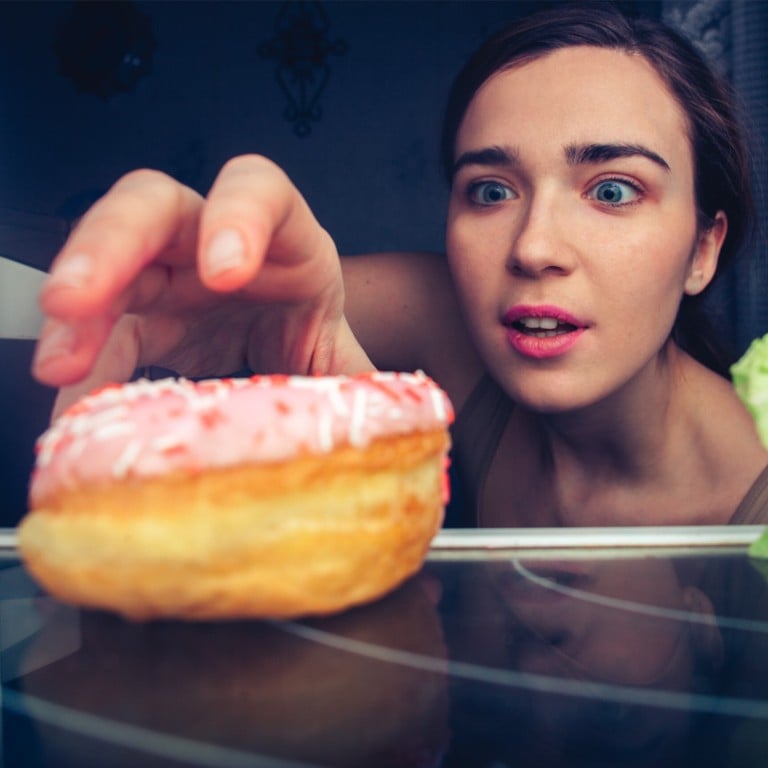
Just eaten and you’re hungry again? How big dips in blood sugar levels make you eat more and can ruin your diet
- A large study shows a link between big drops in glucose levels and the struggle to lose weight or keep it off
- People who experience these larger drops feel hungrier and consume more calories
A new study – the biggest of its kind, monitoring 1,070 people over two weeks and including 8,000 breakfasts and 70,000 meals in total – indicates that people who experience big drops in blood sugar levels reasonably quickly after eating end up feeling hungrier and consume hundreds more calories during the day than others. It’s why some people struggle to lose weight, even on diets: they’re not being greedy; they really can’t help that hunger.
The research suggested those whose blood sugar fell faster (registered using stick-on continuous glucose monitors while participants logged sleep, exercise, what they ate and how they felt using technology and apps) experienced nearly 10 per cent more hunger, and waited around half an hour less, on average, before their next meal than ‘little dippers’, despite eating exactly the same meals. The ‘big dippers’ consumed around 300 extra calories – which could translate as an almost 10kg (22-pound) weight gain over a year.
What drives the sensation of hunger? What causes those big dips? And can people avoid them – short circuit the cycle of dips and hunger and weight gain?
Professor John Blundell of the Appetite Control and Energy Balance Research Group at the UK’s University of Leeds who was involved in the study, says a combination of specific foods and individual physiological characteristics cause the big dips in blood glucose.

“We know from many studies that the foods most likely to produce dips are the so-called high glycaemic foods – white bread, boiled rice, potatoes and highly processed carbohydrates – which can be rapidly digested to release glucose. The consumption of certain of these foods in combination with a person’s physiology creates a condition for a rapid rise in blood glucose followed by a sharp fall, leading to a low level blood glucose (a glucose dip). This dip is a form of transient hypoglycaemia and signals to the brain a potential low availability of energy.”
And that’s what prompts the sensation of true hunger, which Blundell describes as “a biological drive to eat generated by the demand for energy to maintain the body’s vital organs – heart, brain, liver, kidneys and so on – together with muscle required for activity”.
Middle-age weight gain is avoidable – but you have to put the effort in
The problem is that we don’t always eat when we’re biologically hungry, when we really need those calories. Sometimes the desire to eat can be triggered by environmental cues – the smell of freshly baked bread, the abundance of food on display or just because everybody else is eating.
Sally Poon Shi-Po, a dietitian and the current chairman of Hong Kong’s Practising dietitians Union, says you could be experiencing a craving: “I just feel like some chocolate.” You could be bored, tired or stressed, and all of these things, she says, prompt a hunger-like sensation.
“We call this ‘emotional eating’,” she says, “when people crave something sweet or savoury such as chocolate, cakes, biscuits, ice cream, crisps.” That’s usually the result of looking to fill a gap that might be psychological and not physiological.

Blundell describes humans as ‘episodic eaters’. The intervals between meals are necessary for the body to process and metabolise nutrients, to absorb them usefully, and these intervals are important gaps during which the biological drive – real hunger – is blocked and food intake is inhibited, called satiety.
Before a meal, hunger is normally high partly due to the stomach’s production of the hormone ghrelin, which stimulates appetite, Poon says. But after eating, the hunger drops off, body glucose rises and then falls off. It’s why you’re often encouraged to wait 10 minutes after eating if you feel like a second helping: to let the systems catch up with one another.
Ordinarily this rising and falling ought to sync with healthy intervals and regular mealtimes. Except some people experience a steep and sudden drop which hastens feelings of premature hunger.
Irritable bowel syndrome: six ways to relieve its painful symptoms
How do you avoid the big dips? If you’re susceptible, says Blundell, it might help to avoid “certain high glycaemic foods and instead eat foods that generate a milder glucose reaction”. In other words, eat more complex carbohydrates.
Simple high sugar carbohydrates include ‘white bread and rice’, confectionery and pasta. These are foods that have a simple molecular structure and are broken down easily, causing your blood sugar to rise quickly and drop fast (which in turn leads to that early hunger sometimes accompanied by feelings of sugar lows, ‘transient hypoglycaemia’).
Complex carbohydrates, on the other hand, composed of multiple chains of sugars, don’t break down as quickly and so the energy they deliver sustains for longer such as whole wheat and whole grains, like brown rice.
Four easy ways to avoid that ‘hangry’ feeling – by eating right
So if you’re a big dipper, it doesn’t mean you need to eat little meals, it might just mean you need to eat smarter and have more complex carbs. It certainly doesn’t mean you’re a glutton.

